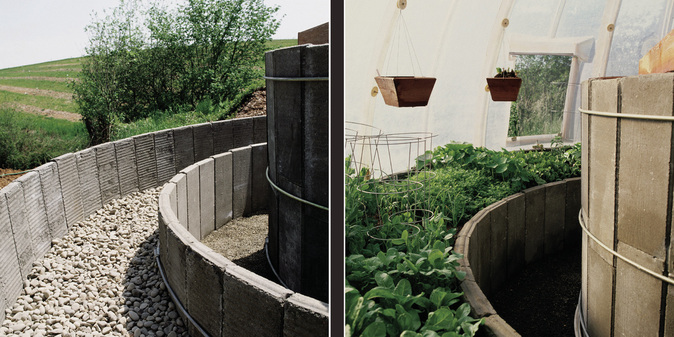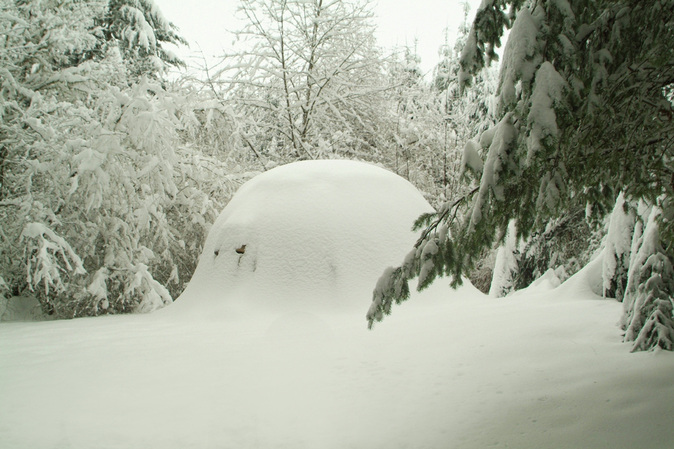PRINCIPLES OF THE BIODOME GARDEN
The Biodome Garden incorporates all the principles of a biome--a plant and animal community in a dynamic equilibrium. THE BIODOME GARDEN BOOK describes this concept with photographs and diagrams. Basically, the circular layout of the raised vegetable beds, with the translucent fiberglass dome above, takes maximum advantage of the sun's warmth. Because solar collectors achieve their utmost potential when tilted 90 degrees to the sun's rays, the dome is the most perfect shape to act as this collector because it allows full solar radiation to be received daily and seasonally with the sun's movement across the sky.
Beneath this dome, a mini-universe teaming with life exists. Aquatic animals provide a protein food source while also producing fertilizer for the vegetable beds. These aquatic animals exist on other aquatic animals, insects, larvae, and plants that inhabit their world. Vegetables, fruit, mushrooms, herbs and other plantings provide a pesticide-free, organically-grown food source rich in natural vitamins and minerals.
Beneath the soil of the raised vegetable beds in the Biodome Garden, and within the compost bin, earthworms loosen debris while dropping high-nutrient castings, and their tunneling holes allow water, nutrients, and oxygen to filter down to the root zone. While thriving on the nitrogen-rich soil and water provided by the fist tank, the earthworms in turn become a valuable source of fish food. Information on how to raise and maintain earthworms is also covered in THE BIODOME GARDEN BOOK.
This mini-universe creates its own micro-climate. As the sun warms the atmosphere within the Biodome Garden, warm air particles rise with the natural configuration of the dome, converge and descend, causing air currents. Moisture from the 850-gallon fish tank rises, collects on the underside of the dome and runs back toward the raised vegetable beds, while the water from the fish tank brings natural, organic, nutrients to the plants.
Beneath this dome, a mini-universe teaming with life exists. Aquatic animals provide a protein food source while also producing fertilizer for the vegetable beds. These aquatic animals exist on other aquatic animals, insects, larvae, and plants that inhabit their world. Vegetables, fruit, mushrooms, herbs and other plantings provide a pesticide-free, organically-grown food source rich in natural vitamins and minerals.
Beneath the soil of the raised vegetable beds in the Biodome Garden, and within the compost bin, earthworms loosen debris while dropping high-nutrient castings, and their tunneling holes allow water, nutrients, and oxygen to filter down to the root zone. While thriving on the nitrogen-rich soil and water provided by the fist tank, the earthworms in turn become a valuable source of fish food. Information on how to raise and maintain earthworms is also covered in THE BIODOME GARDEN BOOK.
This mini-universe creates its own micro-climate. As the sun warms the atmosphere within the Biodome Garden, warm air particles rise with the natural configuration of the dome, converge and descend, causing air currents. Moisture from the 850-gallon fish tank rises, collects on the underside of the dome and runs back toward the raised vegetable beds, while the water from the fish tank brings natural, organic, nutrients to the plants.
Masonry walls, rocks and earth masses within the Biodome Garden, along with water volume in the fish tank, act as solar heat collectors and storage areas, radiating the absorbed heat into the biosphere during the night. This heat, combined with heat produced by the compost bin, helps provide winter warmth. The reverse takes place during the summer months, when the water in the fish tank acts as a heat absorber, helping cool the air within the Biodome Garden. When all elements are combined and working, the unit provides an energy-efficient means of producing food that is free from pesticides and chemical fertilizers. It is also a unit capable of producing fruits and vegetables, with a minimum of water, on a limited area of space.
Of course, there are times of the year when the sun can't get through at all, which means there may be interruptions to your growing season. And not every part of the country provides a temperate climate conducive to year-around growth. But with a Biodome Garden, the growing season of almost any part of the country can be extended far beyond that of an outside garden. But even when the "sky falls in," your growing dome, nestled securely under whatever depth of snow comes with old Jack Frost, will still be in tact. Two feet covers the dome above. Six feet wouldn't have made a difference, except to the little plants struggling for light. But, alas, the sun does come out again, and all is well... unless you chose to build a conventional greenhouse, which would probably collapse under the weight of the snow.


